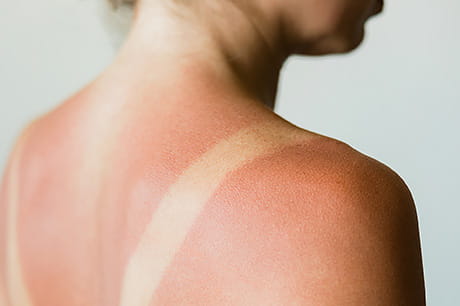How to treat a sunburn
Getting a sunburn isn’t high on anyone’s to-do list. So when you’re feeling the burn, turn to these easy remedies for relief.
Before we head outside for a day of fun in the sun, most of us lather ourselves with sunblock. Sometimes, though, we forget. And forgetting can leave you sporting a red, uncomfortable sunburn. If you’ve been burned recently, treatment is as simple as looking in your medicine cabinet.
What is a sunburn?
“A sunburn happens when your skin is damaged from exposure to UV rays,” says Jeanne Gricoski, DO, an internal medicine physician at Geisinger. “That exposure can lead to a painful, red burn.”
A burn can happen fast. So even if you only plan to be outside for a few minutes, don’t forget your sun protection.
Sunburns don’t just happen in the summer, either. Anytime you’re out in the sun, even in the winter, you can get burned.
Any part of your body that’s exposed can burn. And sometimes covered areas can, too. Wearing clothing with openings (like open-shoulder or mesh tops) can also lead to burns.
Besides the telltale redness, sunburn symptoms can include:
- Warm or hot skin
- Itchiness
- Blisters
- Pain or swelling
“More severe burns can cause flu-like symptoms,” Dr. Gricoski says.
Treating and healing sunburn
If you’ve been scorched by the sun, there are quick, easy ways to recover and soothe your suffering skin. Consider these:
1. Cool off and moisturize
“The sun drains your skin of moisture, so it’s important to moisturize to prevent itching and peeling,” says Dr. Gricoski.
After you’ve been out in the sun, a cool shower can help ease the pain and help you start to heal. But don’t stay in too long — cold water can dry out your skin. When you feel refreshed, pat your skin dry. Then apply a moisturizer to wet skin to start the healing process.
Start with a thicker cream to help lock in extra moisture. Avoid oil-based creams like petroleum jelly, which can trap heat in your skin. Moisturizers with lidocaine or benzocaine can irritate the skin, so take caution. Instead, look for one that contains aloe.
2. Soothe your skin
Aloe is a natural sunburn remedy that can stop the burning sensation and help prevent swelling.
To treat sunburn with aloe, many people cut open a thick aloe leaf and apply the sap directly to their skin. If you don’t have an aloe plant nearby, you can also use aloe gels and oils from your local drugstore.
Applying aloe directly from a plant or aloe gel or oil two or three times a day can help you reduce the pain and inflammation that comes along with sunburn.
“While your skin heals, wear loose-fitting clothing to protect it from further damage,” notes Dr. Gricoski.
3. Reduce swelling and pain
Sunburns can be unpleasant, especially for the first two or three days after getting burnt.
If you notice swelling, take an anti-inflammatory medication like ibuprofen, aspirin or naproxen. This can help reduce swelling and pain. Before you take any anti-inflammatory medicine, check with your healthcare provider. They can recommend how much to take and how often to take it.
4. Drink fluids
Sunburn causes your skin and the rest of your body to dehydrate.
The best way to replenish your skin is to rehydrate immediately and for the next several days.
Besides water, consider sipping on:
- Sports drinks
- Broth
- Juices
- Milk
“Drinking water and sports drinks can help hydrate you and replenish electrolytes, which can help avoid dehydration,” Dr. Gricoski says.
5. Stay out of the sun
While your skin is on the mend, try to limit your sun exposure. This can help you avoid getting a worse burn. And help your skin recover.
If you do have to head out, keep your skin covered. Wear sunscreen, a hat and sunglasses. Be sure to stay hydrated while you’re out, too.
Stopping them before they start
Since sunburns are common, you might think that getting one isn’t doing any damage. However, research shows that a few bad sunburns can increase your risk of developing skin cancer. That’s why it’s so important to slather on — and re-apply — sunscreen to prevent future sunburns.
“The best treatment is prevention,” says Dr. Gricoski. “Never leave the house without your SPF.”
The next time your skin is exposed to the sun (even on cloudy days), be sure to take steps to protect yourself. Our dermatologists suggest that you:
- Apply sunscreen (at least SPF 15) and re-apply every two hours
- Stay in the shade
- Wear protective clothing, including a hat and sunglasses
And remember: if a long day in the sun leaves you with a fever, chills or dizziness, or you develop blisters across a large portion of your skin, call your healthcare provider. These can be signs of infection.
Next steps:
SPF What? Decoding your sunscreen
Sunglasses year-round? Survey says, yes.
Make a primary care appointment





